Bolin Ni
Practical Continual Forgetting for Pre-trained Vision Models
Jan 16, 2025Abstract:For privacy and security concerns, the need to erase unwanted information from pre-trained vision models is becoming evident nowadays. In real-world scenarios, erasure requests originate at any time from both users and model owners, and these requests usually form a sequence. Therefore, under such a setting, selective information is expected to be continuously removed from a pre-trained model while maintaining the rest. We define this problem as continual forgetting and identify three key challenges. (i) For unwanted knowledge, efficient and effective deleting is crucial. (ii) For remaining knowledge, the impact brought by the forgetting procedure should be minimal. (iii) In real-world scenarios, the training samples may be scarce or partially missing during the process of forgetting. To address them, we first propose Group Sparse LoRA (GS-LoRA). Specifically, towards (i), we introduce LoRA modules to fine-tune the FFN layers in Transformer blocks for each forgetting task independently, and towards (ii), a simple group sparse regularization is adopted, enabling automatic selection of specific LoRA groups and zeroing out the others. To further extend GS-LoRA to more practical scenarios, we incorporate prototype information as additional supervision and introduce a more practical approach, GS-LoRA++. For each forgotten class, we move the logits away from its original prototype. For the remaining classes, we pull the logits closer to their respective prototypes. We conduct extensive experiments on face recognition, object detection and image classification and demonstrate that our method manages to forget specific classes with minimal impact on other classes. Codes have been released on https://github.com/bjzhb666/GS-LoRA.
Xwin-LM: Strong and Scalable Alignment Practice for LLMs
May 30, 2024Abstract:In this work, we present Xwin-LM, a comprehensive suite of alignment methodologies for large language models (LLMs). This suite encompasses several key techniques, including supervised finetuning (SFT), reward modeling (RM), rejection sampling finetuning (RS), and direct preference optimization (DPO). The key components are as follows: (1) Xwin-LM-SFT, models initially finetuned with high-quality instruction data; (2) Xwin-Pair, a large-scale, multi-turn preference dataset meticulously annotated using GPT-4; (3) Xwin-RM, reward models trained on Xwin-Pair, developed at scales of 7B, 13B, and 70B parameters; (4) Xwin-Set, a multiwise preference dataset in which each prompt is linked to 64 unique responses generated by Xwin-LM-SFT and scored by Xwin-RM; (5) Xwin-LM-RS, models finetuned with the highest-scoring responses from Xwin-Set; (6) Xwin-LM-DPO, models further optimized on Xwin-Set using the DPO algorithm. Our evaluations on AlpacaEval and MT-bench demonstrate consistent and significant improvements across the pipeline, demonstrating the strength and scalability of Xwin-LM. The repository https://github.com/Xwin-LM/Xwin-LM will be continually updated to foster community research.
Enhancing Visual Continual Learning with Language-Guided Supervision
Mar 24, 2024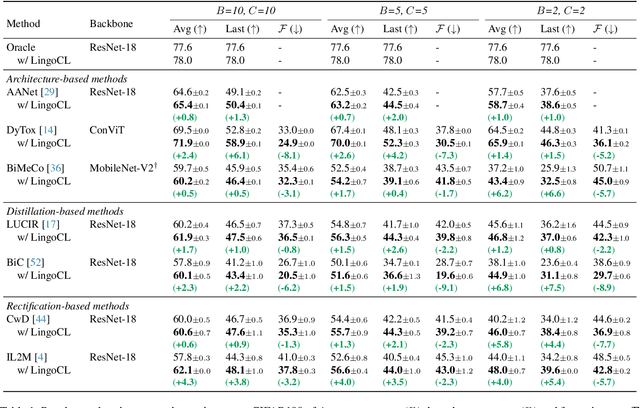
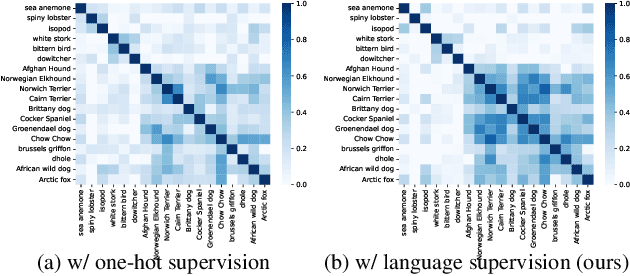
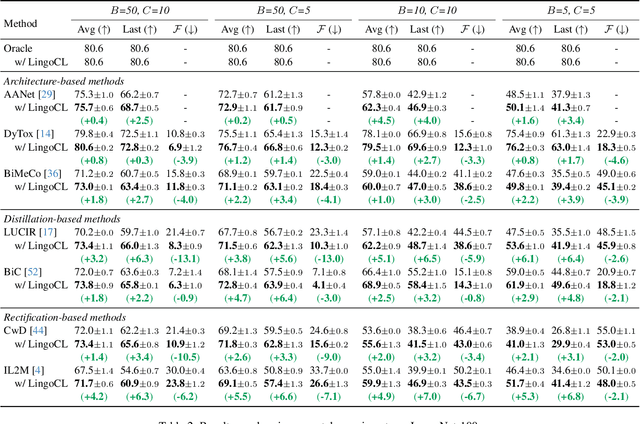
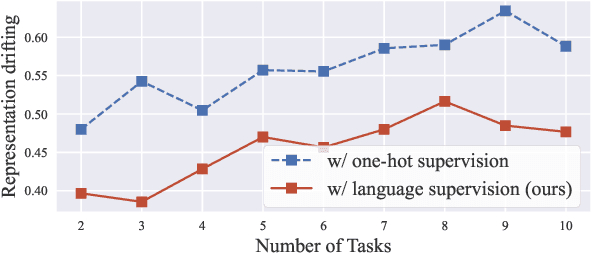
Abstract:Continual learning (CL) aims to empower models to learn new tasks without forgetting previously acquired knowledge. Most prior works concentrate on the techniques of architectures, replay data, regularization, \etc. However, the category name of each class is largely neglected. Existing methods commonly utilize the one-hot labels and randomly initialize the classifier head. We argue that the scarce semantic information conveyed by the one-hot labels hampers the effective knowledge transfer across tasks. In this paper, we revisit the role of the classifier head within the CL paradigm and replace the classifier with semantic knowledge from pretrained language models (PLMs). Specifically, we use PLMs to generate semantic targets for each class, which are frozen and serve as supervision signals during training. Such targets fully consider the semantic correlation between all classes across tasks. Empirical studies show that our approach mitigates forgetting by alleviating representation drifting and facilitating knowledge transfer across tasks. The proposed method is simple to implement and can seamlessly be plugged into existing methods with negligible adjustments. Extensive experiments based on eleven mainstream baselines demonstrate the effectiveness and generalizability of our approach to various protocols. For example, under the class-incremental learning setting on ImageNet-100, our method significantly improves the Top-1 accuracy by 3.2\% to 6.1\% while reducing the forgetting rate by 2.6\% to 13.1\%.
Defying Imbalanced Forgetting in Class Incremental Learning
Mar 22, 2024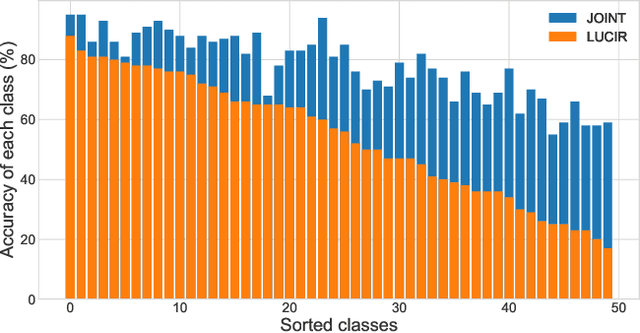

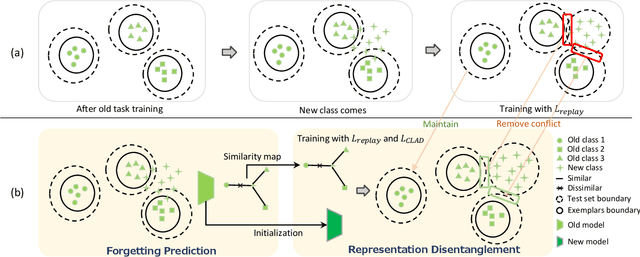
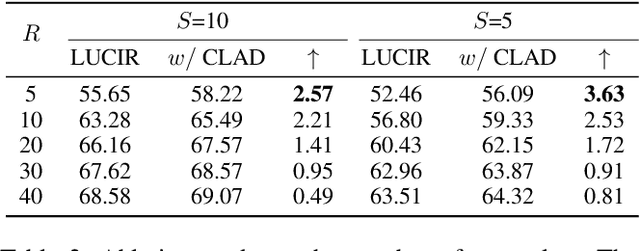
Abstract:We observe a high level of imbalance in the accuracy of different classes in the same old task for the first time. This intriguing phenomenon, discovered in replay-based Class Incremental Learning (CIL), highlights the imbalanced forgetting of learned classes, as their accuracy is similar before the occurrence of catastrophic forgetting. This discovery remains previously unidentified due to the reliance on average incremental accuracy as the measurement for CIL, which assumes that the accuracy of classes within the same task is similar. However, this assumption is invalid in the face of catastrophic forgetting. Further empirical studies indicate that this imbalanced forgetting is caused by conflicts in representation between semantically similar old and new classes. These conflicts are rooted in the data imbalance present in replay-based CIL methods. Building on these insights, we propose CLass-Aware Disentanglement (CLAD) to predict the old classes that are more likely to be forgotten and enhance their accuracy. Importantly, CLAD can be seamlessly integrated into existing CIL methods. Extensive experiments demonstrate that CLAD consistently improves current replay-based methods, resulting in performance gains of up to 2.56%.
Continual Forgetting for Pre-trained Vision Models
Mar 18, 2024



Abstract:For privacy and security concerns, the need to erase unwanted information from pre-trained vision models is becoming evident nowadays. In real-world scenarios, erasure requests originate at any time from both users and model owners. These requests usually form a sequence. Therefore, under such a setting, selective information is expected to be continuously removed from a pre-trained model while maintaining the rest. We define this problem as continual forgetting and identify two key challenges. (i) For unwanted knowledge, efficient and effective deleting is crucial. (ii) For remaining knowledge, the impact brought by the forgetting procedure should be minimal. To address them, we propose Group Sparse LoRA (GS-LoRA). Specifically, towards (i), we use LoRA modules to fine-tune the FFN layers in Transformer blocks for each forgetting task independently, and towards (ii), a simple group sparse regularization is adopted, enabling automatic selection of specific LoRA groups and zeroing out the others. GS-LoRA is effective, parameter-efficient, data-efficient, and easy to implement. We conduct extensive experiments on face recognition, object detection and image classification and demonstrate that GS-LoRA manages to forget specific classes with minimal impact on other classes. Codes will be released on \url{https://github.com/bjzhb666/GS-LoRA}.
FP8-LM: Training FP8 Large Language Models
Oct 27, 2023



Abstract:In this paper, we explore FP8 low-bit data formats for efficient training of large language models (LLMs). Our key insight is that most variables, such as gradients and optimizer states, in LLM training can employ low-precision data formats without compromising model accuracy and requiring no changes to hyper-parameters. Specifically, we propose a new FP8 automatic mixed-precision framework for training LLMs. This framework offers three levels of FP8 utilization to streamline mixed-precision and distributed parallel training for LLMs. It gradually incorporates 8-bit gradients, optimizer states, and distributed learning in an incremental manner. Experiment results show that, during the training of GPT-175B model on H100 GPU platform, our FP8 mixed-precision training framework not only achieved a remarkable 42% reduction in real memory usage but also ran 64% faster than the widely adopted BF16 framework (i.e., Megatron-LM), surpassing the speed of Nvidia Transformer Engine by 17%. This largely reduces the training costs for large foundation models. Furthermore, our FP8 mixed-precision training methodology is generic. It can be seamlessly applied to other tasks such as LLM instruction tuning and reinforcement learning with human feedback, offering savings in fine-tuning expenses. Our FP8 low-precision training framework is open-sourced at {https://github.com/Azure/MS-AMP}{aka.ms/MS.AMP}.
Pro-tuning: Unified Prompt Tuning for Vision Tasks
Aug 14, 2022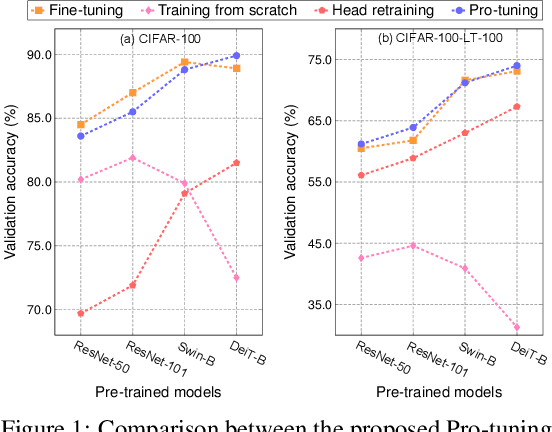
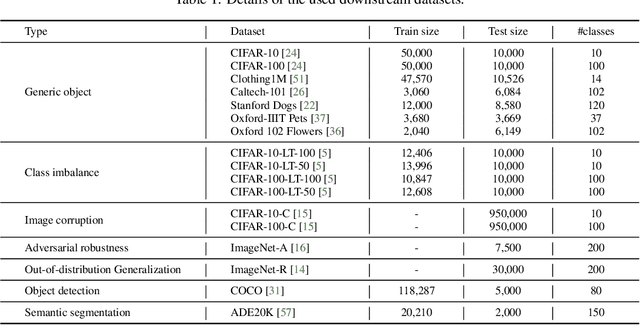
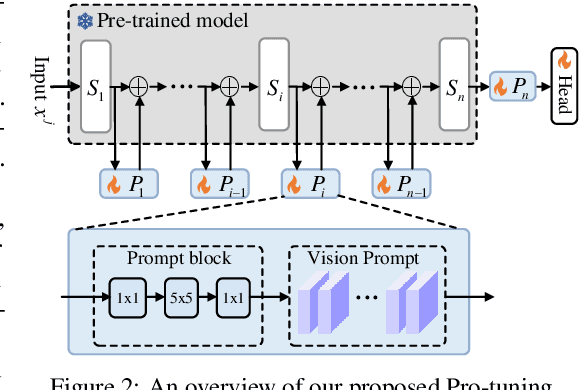
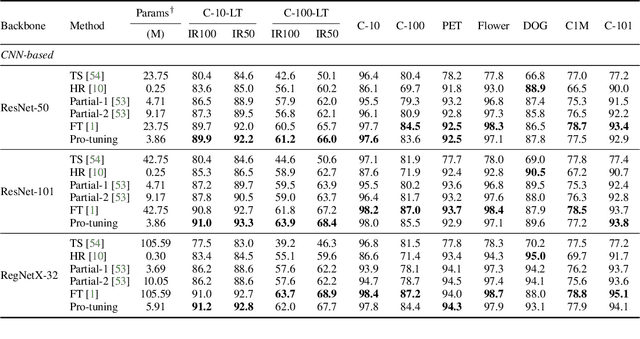
Abstract:In computer vision, fine-tuning is the de-facto approach to leverage pre-trained vision models to perform downstream tasks. However, deploying it in practice is quite challenging, due to adopting parameter inefficient global update and heavily relying on high-quality downstream data. Recently, prompt-based learning, which adds a task-relevant prompt to adapt the downstream tasks to pre-trained models, has drastically boosted the performance of many natural language downstream tasks. In this work, we extend this notable transfer ability benefited from prompt into vision models as an alternative to fine-tuning. To this end, we propose parameter-efficient Prompt tuning (Pro-tuning) to adapt frozen vision models to various downstream vision tasks. The key to Pro-tuning is prompt-based tuning, i.e., learning task-specific vision prompts for downstream input images with the pre-trained model frozen. By only training a few additional parameters, it can work on diverse CNN-based and Transformer-based architectures. Extensive experiments evidence that Pro-tuning outperforms fine-tuning in a broad range of vision tasks and scenarios, including image classification (generic objects, class imbalance, image corruption, adversarial robustness, and out-of-distribution generalization), and dense prediction tasks such as object detection and semantic segmentation.
Expanding Language-Image Pretrained Models for General Video Recognition
Aug 04, 2022



Abstract:Contrastive language-image pretraining has shown great success in learning visual-textual joint representation from web-scale data, demonstrating remarkable "zero-shot" generalization ability for various image tasks. However, how to effectively expand such new language-image pretraining methods to video domains is still an open problem. In this work, we present a simple yet effective approach that adapts the pretrained language-image models to video recognition directly, instead of pretraining a new model from scratch. More concretely, to capture the long-range dependencies of frames along the temporal dimension, we propose a cross-frame attention mechanism that explicitly exchanges information across frames. Such module is lightweight and can be plugged into pretrained language-image models seamlessly. Moreover, we propose a video-specific prompting scheme, which leverages video content information for generating discriminative textual prompts. Extensive experiments demonstrate that our approach is effective and can be generalized to different video recognition scenarios. In particular, under fully-supervised settings, our approach achieves a top-1 accuracy of 87.1% on Kinectics-400, while using 12 times fewer FLOPs compared with Swin-L and ViViT-H. In zero-shot experiments, our approach surpasses the current state-of-the-art methods by +7.6% and +14.9% in terms of top-1 accuracy under two popular protocols. In few-shot scenarios, our approach outperforms previous best methods by +32.1% and +23.1% when the labeled data is extremely limited. Code and models are available at https://aka.ms/X-CLIP
Searching the Search Space of Vision Transformer
Nov 29, 2021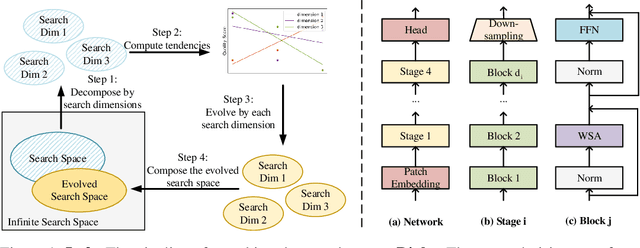
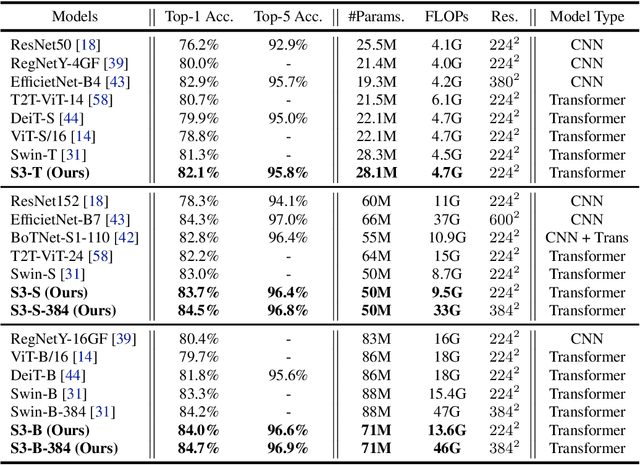
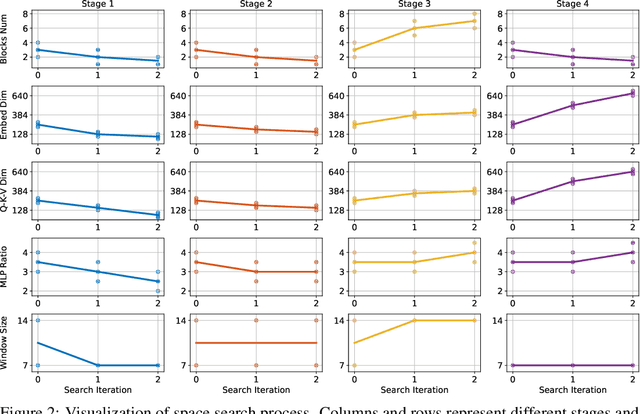

Abstract:Vision Transformer has shown great visual representation power in substantial vision tasks such as recognition and detection, and thus been attracting fast-growing efforts on manually designing more effective architectures. In this paper, we propose to use neural architecture search to automate this process, by searching not only the architecture but also the search space. The central idea is to gradually evolve different search dimensions guided by their E-T Error computed using a weight-sharing supernet. Moreover, we provide design guidelines of general vision transformers with extensive analysis according to the space searching process, which could promote the understanding of vision transformer. Remarkably, the searched models, named S3 (short for Searching the Search Space), from the searched space achieve superior performance to recently proposed models, such as Swin, DeiT and ViT, when evaluated on ImageNet. The effectiveness of S3 is also illustrated on object detection, semantic segmentation and visual question answering, demonstrating its generality to downstream vision and vision-language tasks. Code and models will be available at https://github.com/microsoft/Cream.
 Add to Chrome
Add to Chrome Add to Firefox
Add to Firefox Add to Edge
Add to Edge